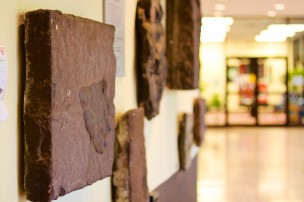Long, long ago, before Fisk Hall was built or the Connecticut River existed, giant beasts roamed the hills of Middletown and nearby Portland. Most members of the University community know this from the impressive array of prehistoric footprints on display in the Exley Science Center lobby. The Argus spoke with Research Professor of Earth and Environmental Sciences Ellen Thomas to find out more about these footprints, what they can tell us about the prehistoric era, and their history at Wesleyan.
“I don’t know if, as a child, you ever watched ‘The Land Before Time,’” Thomas said. “Early in that movie, you have all of the disasters with the big lava flows. That’s here! Those are the lava flows they’re talking about; there is a basis of geologic reality in that.”
As everyone must recall, in that seminal children’s classic, Littlefoot and his friends must escape from a massive volcano explosion by moving westward. Based on a look at the historical record, the closest analogue to this disaster was a seismic splitting of the continents about 200 million years ago, around what’s known as the Triassic-Jurassic boundary. At the time, Conn. was directly connected to what are now known as North Africa and Western Europe. As the supercontinent Pangaea split apart, the resulting volcanic eruptions and basalt lava flows caused a mass extinction, all right here in the University’s backyard.
“If you drive towards Meriden, along the road you see these big basalt flows,” Thomas said. “In between was land; at the time it was closer to the equator than Connecticut was now, so it was kind of hot and humid. Lakes formed, and dinosaurs were wandering around. It was kind of desert-like but with huge lakes forming, kind of like the East African Rift Valley.”
Thankfully, many of that period’s dinosaurs left footprints that remained intact around the Connecticut Valley. The University’s particular collection of footprints was discovered during a construction excavation at the Portland Brownstone Quarries in 1966.
“The road men noted that there was something interesting there, something funny there, so the person they asked to give an opinion was [Professor] Joe Webb Peoples,” said Thomas. “He was fairly enthusiastic about the footprints, started to describe them, invited people over.… They contacted a number of professors, spearheaded by Joe Webb Peoples, to establish the Dinosaur State Park.”
In exchange for helping to found and preserve the state park, Peoples got to take a few of the footprints home to Wesleyan.
According to Thomas, actual dinosaur fossils have proven to be scarce in the region, with only a couple of skeletons having been uncovered. However, although they may seem less exciting than fossils, dino footprints can actually help scientists discover things about dinosaurs that fossils can’t illustrate, namely, their behavior patterns.
“If you think of yourself, the distance between your footprints when you’re walking tells something about how tall you are, right?” Thomas said. “And so, if you’re measuring enough dinosaur footprints, even if you don’t see a single skeleton, you can construct how tall they were. The footprints can show if they were running or not because you have a different foot imprint if you’re running versus walking.”
With enough footprints to represent a timeline of dinosaur behavior (like the huge grounds at the Dinosaur State Park), scientists have been able to infer complex dinosaur habits like herding and parenting behaviors.
In more recent decades, Columbia professor Paul E. Olsen and other researchers have done work to identify the species to which footprints on display at the University belong. Because footprints even of the same organism can be so variable, the work has been at times difficult and inconclusive, but the species identifications of the dinosaurs are now labelled in Exley. In addition to a variety of dinosaur footprints, Exley is also home to several footprints from phytosaurs, an extinct group of crocodile-esque reptiles.
For more prehistoric fun on campus, one can seek out the Joe Webb Peoples Earth and Environmental Science Museum on the fourth floor of Exley. According to Thomas, however, students might need to venture to more treacherous places if they want to see a truly impressive footprint collection.
“If you really want to see dinosaur footprints, you’ve got to go to Amherst College,” she said.

Comments are closed